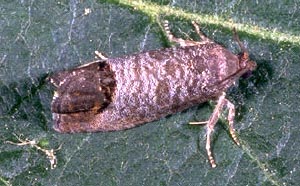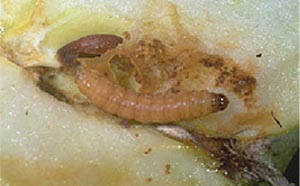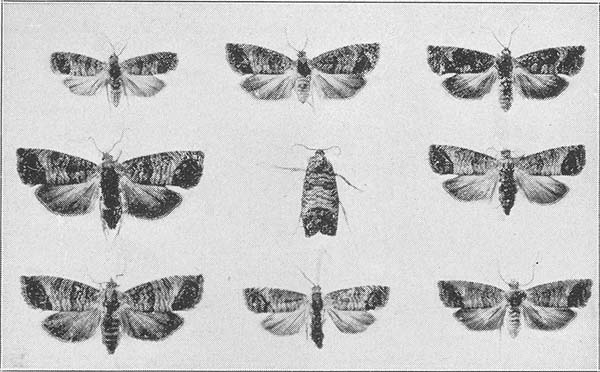


BUG OF THE MONTH: April 1999
Codling Moth
Cydia pomonella
Order Lepidoptera, Family Tortricidae
(Bugs of Wormy Apples, Part 1)
Copyright © 1999 by Louise Kulzer
This article originally appeared in Scarabogram, April 1999, New Series No. 228, pp. 2-3; with additions in June 1999, No. 230, pp. 2-3.
Yes, I know they're not as much fun as the charismatic "large, fuzzy megabugs," but apple pests affect most of us that have an apple tree or two. Hence it's a good idea to know a bit about them. There are two "worm" pests of apples of concern in our area, the apple codling moth: Cydia pomonella, micromoth family Tortricidae, and the apple maggot: Rhagolethis pomonella, fruit fly family Tephritidae. However, WSU Cooperative Extension doesn't currently consider the apple maggot too troublesome in the Puget Sound area, although it's a serious pest in the Portland area [since this was written, apple maggot has become much worse here]. So let's start with the codling moth.
 |
| Codling moth adult (U. of Kentucky photo) |
 |
| Apple with codling moth larva (USDA painting) |
 |
| Codling moth larva (U. of Kentucky photo) |
Just like the wimps among us, codling moth caterpillars spend the winter snuggled in cocoons, usually in loose bark or other plant material. In spring, about the time apples begin to blossom, the resting caterpillars complete their metamorphosis into adult moths, and by full bloom, the adults are freshly emerged. They are half-inch grayish things with handsome brown patches and bands, and horny as all get-out. The adult moths spend the heady spring days (actually nights) looking to get mated. When successful, the females fly around apple trees, usually at dusk, laying their flat, oval, transparent eggs on leaves and fruit.
In a week or two the eggs hatch and the tiny caterpillars (we're talking 1/10 of an inch here) head for the nearest fruit. Chewing through the side or the calyx (the apple's bellybutton), they eat into the core. They live happily within the core all summer until they are full-grown teen-age caterpillars. They then eat their way through the flesh of the apple to the outside and crawl down the tree to a scaly shelter in the bark or ground. There they spin a cocoon, content to lie in a sort of suspended animation through the long dark winter. Scientists call this stage "diapause." It's akin to your grown teenager living on a beach in Mexico for a while, before he or she finds a niche in the adult world. Come spring, the caterpillar pupates, emerges shortly as an adult, and the cycle starts again. Actually, there is also a second cycle, for precocious adults who mate early can produce caterpillars that mature while it's still summer. That means they can just go through their regular metamorphosis into adults and forego the diapause thing. But more about this later.
In the mean time, here we are with wormy apples. And maybe also with wormy pears, plums, quince and crabapples; even walnuts! For Wescott (1953) and Phillips & Barnes (1975) also list those fruits as being of interest to the codling moth. But aside from the core being filled with a season's worth of caterpillar crap and the brown tunnel through the sweet flesh, the codling moth doesn't do too much damage to the apple from the viewpoint of the robust gardener. The apple is still OK for baking, and for the braver among us, for fresh eating (just don't eat the core). However, apples with codling moth worms don't store well. Thus, the codling moth is a big concern for commercial growers.
Early-on, the cure for codling moth was lead arsenate. As codling moths became resistant, the dose of lead arsenate increased, and concern for residues on fruit grew. In the 1940s, DDT replaced lead arsenate as the pesticide of preference (USDA 1952). We all know the story from there.
If you do need good control for the codling moth, call your extension agent. There's a new "birth-control" - like method involving keeping track of degree days that can more effectively pinpoint when chemicals should be applied. They can explain it to you.
But there is also a simple control the home gardener can apply. Remember those caterpillars that need to crawl down the trunk to rest in cocoons before they become adults? If you wrap the trunk with corrugated cardboard or burlap, many of the caterpillars will find that a perfectly suitable shelter and stop there to spin their cocoons. Then you can take the cardboard off periodically and burn it, reducing the number of moths next spring. Backing the cardboard with cotton batting may work even better. (I got this tip from Sharon Collman, local bug expert).
A reader of another version of this article wished to know whether mid-summer (as another writer specified) is the right time to wrap the trunk. Remember, we're wrapping the trunks to intercept the codling moth larvae after they're grown and eat their way out of the apple and are crawling down the tree to veg-out or pupate, as their nature dictates. So when does this happen? Truth is, mid-summer is pretty good advice, even if someone else gave it, since we don't really have data about when the earliest larvae start moving. We know the adult moths start flying by mid to late May, that eggs take 2 weeks to hatch, and that the apples need to start developing before the larvae can get very big. So when your apples are about half-sized, then is when I'd start wrapping the trunk, whatever time that happens to be (most likely July). Likely you won't intercept many larvae at first, but the pace should pick up in August and September.
And by the way, there is a bit of disagreement about what the wrapping does. Some think it just serves to get the larvae tangled up, and so the wrapping must be "emptied" regularly to effectively reduce numbers. (So why not use tanglefoot, huh?) Regularly means at least weekly. Others think the larvae pupate in the wrapping, in which case the larvae still need to be destroyed, but doing it at less frequent intervals would work fine. So which is it? Probably both. A safe practice would be to empty the wrapping every two weeks until you start to get lots of worms (5-10 is lots), then do it weekly until the numbers taper off. If you just get pupae and no worms, you can ease off a bit (yes I know, that's so subjective).
Now let's go back a minute. I said to destroy the larvae, didn't I? A reader asks, what does "destroyed" mean exactly? I can tell this reader never raised boys. By "destroyed" I mean doing something that kills the larvae/pupae, or at least isolates them from contact with apple trees should they survive and emerge later. Let your imagination soar. Crush them, boil them, drown them & flush them down the toilet, grind them in your garbage disposal, send them to Cedar Hills landfill. Test: Should you compost them? Answer: Not unless you want wormy apples all over again next year, or you make a really mean, hot compost! Test 2: Should you feed them to your chickens? Well, will your chickens make damn sure to find the moth larvae and eat them? If so, OK. If not, no go. So it depends on your chickens' ability to search and destroy. If there's any doubt, find another method of disposal.
I should add, while I'm at it, that you can also buy a trap that targets the codling moth adults. It uses a patented pheromone to lure in males who think a spicy female is calling their name. The trap is a cardboard box-like affair with sticky sides. You hang it high in your apple tree when the adults are around. Remember when that is? Right - when the tree blooms. However, there is evidence that adult moths can also emerge later, the next generation of those early "trekky" moths. So if you have a big codling moth problem, you can go ahead and still put in pheromone traps in June or July and you'll probably still catch some adults. I've seen the "Sure Fire" brand on sale at City People's. Although I haven't tried the codling moth trap, I know that the trap for Indian meal moths works real well. Far better than a swatter or clapping your hands in the air. Scarab Tilbury reports that codling moth traps also catch a few other moth species.
 |
| Pattern variation in codling moth adults (Cornell University) |
But what about the apple maggot I said I'd tell you about? Well, gentle reader, we're out of time for this month. Stay tuned and we'll find out about the other apple villain next month. In the meantime, remember when you see the delightful pale pink of apple blossoms that the codling moths are beginning to stir from their long winter lethargy. And you just might want to sit out at dusk, trying your luck as the moths are - admiring the sexiest of the dull gray forms as they flutter about the blossoms.
References
Beers et al., eds. 1993. Orchard Pests. Yakima: Good Fruit Grower Publishing.
Bessin, Ric. 2001. Codling Moth. University of Kentucky Cooperative Extension Service, Entfacts #203, 2 pp. (photo source. Warning: PDF file.)
Phillips, P.A., and M.M. Barnes. 1975. Host race formation among sympatric apple, walnut and plum populations of Cydia pomonella. Annals of the Entomological Society of America, 68: 1053-1060.
U.S. Department of Agriculture. 1952. Insects: the Yearbook of Agriculture. U.S. Government Printing Office, 780 pp.
Wescott, Cynthia. 1953. Garden Enemies. New York: Van Nostrand, 251 pp.
This page last updated 27 July, 2005